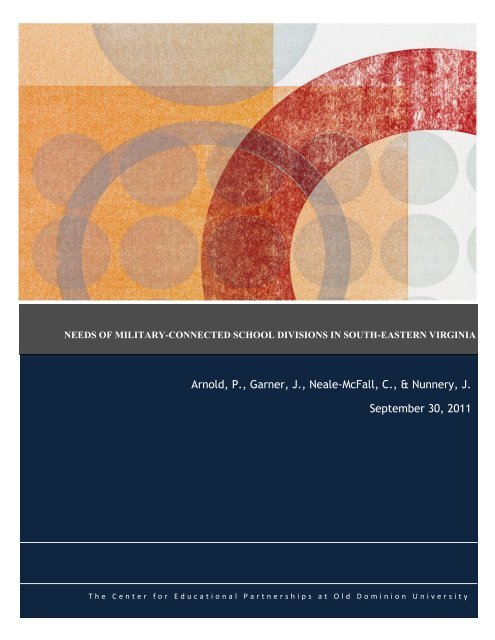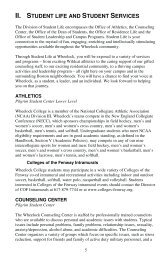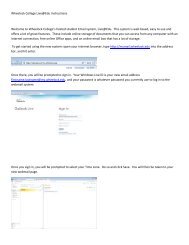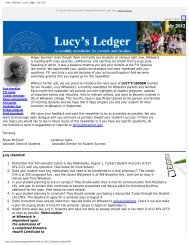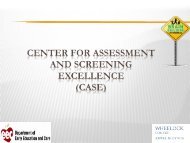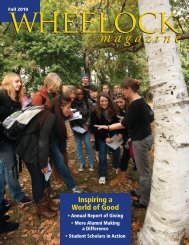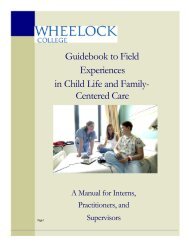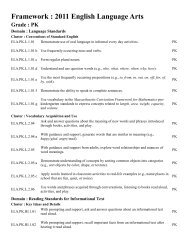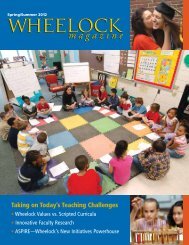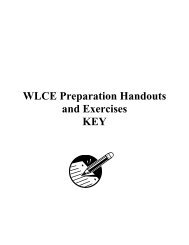Download the study (pdf)
Download the study (pdf)
Download the study (pdf)
You also want an ePaper? Increase the reach of your titles
YUMPU automatically turns print PDFs into web optimized ePapers that Google loves.
connected students as a group, nor to systematically assess and reflect on <strong>the</strong>ir school-wide efforts toprovide a military conscious school environment. We recommend that resources be dedicated tohelping schools establish and share <strong>the</strong>se systems and tools so <strong>the</strong>y are better able to build andsustain comprehensive school wide approaches to meet <strong>the</strong> changing needs of <strong>the</strong>ir militaryconnected students. Doing so would also enhance mechanisms by which school districts andagencies can be held accountable for <strong>the</strong> ways in which resources are being developed and used.4. Enhance school-military partnerships and communications. Most of <strong>the</strong> participants in our<strong>study</strong> mentioned desiring more information about upcoming transitions and deployments so <strong>the</strong>y arebetter able to anticipate needs and target services, as well as more information about resources.While our counselor participants made us aware that many resources do exist, connecting <strong>the</strong>m toteachers so <strong>the</strong>y may be utilized in <strong>the</strong> day to day life of <strong>the</strong> classroom appears to be an area thatrequires more attention. Fewer than 25% of teachers we surveyed indicated <strong>the</strong>y had access to a listof resources and services to support <strong>the</strong> needs of military connected students and fewer than 14%agreed that school staff were well informed about military-based support services for militaryconnected students.In summary, our findings point both to <strong>the</strong> existence of significant awareness and desire tosupport <strong>the</strong> needs of military connected students and a critical need to increase systemic capacity inschools that serve substantial populations of military connected students.5
military connected students that report school personnel perceive one of <strong>the</strong> greatest challenges <strong>the</strong>y faceis meeting <strong>the</strong> increased academic needs of transitioning students due to difference in state and districtcurricula (GAO, 2011). One teacher in our <strong>study</strong> wondered, “How do you fill <strong>the</strong> gaps in <strong>the</strong> amount oftime you have with <strong>the</strong>m? It does make it hard for <strong>the</strong>m. Their social studies [curriculum] in ano<strong>the</strong>rstate is not going to look like what we teach here. They are playing catch up as well as trying to moveforward and <strong>the</strong>re really is not extra support for that.” Participants also noted that <strong>the</strong>re were differencesin curriculum, assessments, and expectations military connected students may experience betweenpublic and DoD schools, between public, private and/or homeschool settings, and in some instancesdifferences between districts or schools within a district. Several participants pointed out that on top ofcoping with gaps, it was not rare for students to have already learned things in <strong>the</strong>ir previous school(s)that had not yet been taught in <strong>the</strong>ir new school, resulting in boredom and wasted instructional time dueto repetition of lessons. These findings are consistent with o<strong>the</strong>r studies which have identified that formilitary connected students, varied requirements from one state to <strong>the</strong> next often results in missedlearning in critical topics and/or repetition of curricula already learned (Bradshaw, Sudhinaraset, Mmari& Blum, 2010).In addition to curricular issues, participants also noted that transitioning students must readjust todifferent teaching methods, pedagogical techniques and pacing in a new school setting. Schooladjustment has been found elsewhere in <strong>the</strong> literature to be a significant stressor for military connectedstudents (Bradshaw et. al, 2010). Participants in our <strong>study</strong> recounted that teachers expend a significantamount of additional effort in facilitating such readjustments and accommodating students until <strong>the</strong>yadjust. Time is required for teachers to learn about new students and induct <strong>the</strong>m into <strong>the</strong> classroom.One teacher made an analogy to <strong>the</strong> start of <strong>the</strong> school year in discussing a problem many mentioned:“Teachers need to get to know <strong>the</strong>ir students very quickly. You almost have to take time away from <strong>the</strong>whole class just to get to know that one kid a little bit better. It’s like going through <strong>the</strong> beginning of <strong>the</strong>school year all over again.” Many participants noted that because of differences in transitioningstudents’ prior knowledge and academic skills, <strong>the</strong> teacher’s ability to differentiate instruction is critical.As noted by one teacher, “The students come in with different skill sets. You need to be able todifferentiate at a higher level and remediate in different ways than you would with a differentpopulation.” Teachers emphasized <strong>the</strong> need to provide a lot of small group and individualizedinstructional opportunities for transitioning students, and described <strong>the</strong> challenges of doing so givenlimited classroom time and resources.Practitioners mentioned remedial support for reading and math as a critical area of need and acapacity that would support transitioning students. In addition, many articulated that <strong>the</strong>re is a need forsystems and tools that provide a quick turn-around diagnosis of present levels of academic functioningfor transitioning military students. As one teacher expressed, “We need to be able to identifyweaknesses quickly because we don’t have a school year to work with. They come in any time during<strong>the</strong> year and I don’t have <strong>the</strong> luxury of wasting any time with a child’s education. I have to teach <strong>the</strong>mas soon as <strong>the</strong>y get here so I have to know what <strong>the</strong>y know and what <strong>the</strong>y don’t know.”Several of <strong>the</strong> school personnel in our <strong>study</strong> mentioned having an initial screening process inplace to assess transitioning students, most frequently in reading, and access to better diagnostic toolsfor assessing transitioning students’ present levels of academic functioning. To provide remediationsupport, some participants mentioned that <strong>the</strong>y had reading specialists and math interventionistsavailable to assist with assessments and academic supports through Title 1 funding. Responses ofprincipals underscored <strong>the</strong> importance of Title 1 resources when applicable; <strong>the</strong>re were significantdifferences expressed among some of <strong>the</strong> principals of Title 1 and non-Title one schools with respect tohow well <strong>the</strong>y felt <strong>the</strong>ir schools were supported in meeting academic needs in general. One principal of8
a school with an almost exclusively military connected population remarked, “My need here is reallyacademic…I have got to provide some sort of intervention. Because I am not a Title 1 school andbecause I meet state accreditation, I have no assistance.” Conversely, <strong>the</strong> principal of a school that isTitle 1 told us, “Academic needs are being met better than social-emotional because of <strong>the</strong> resources ofTitle 1. We are able to do lots of small group. We have an interventionist. We have tutors. We justhave layers and layers.” Therefore, while schools with additional resources for academic supportsemploy <strong>the</strong>m for <strong>the</strong> benefit of military connected students, schools without <strong>the</strong>se additional resourcesmay struggle to meet <strong>the</strong> transition-related academic needs of <strong>the</strong>ir military connected students.Some educators mentioned <strong>the</strong> desire to have access to a better array of diagnostic tools forassessing transitioning students’ present levels of academic functioning. Some mentioned that it wouldbe helpful to have background knowledge of curricula from different states and countries, for bothschool personnel and parents. The comments of one teacher reflect a sentiment expressed by severalacross our <strong>study</strong>, “Sometimes parents are unaware that things are very different from state to state andwhen <strong>the</strong>y get <strong>the</strong>re and <strong>the</strong>ir child is having trouble in school <strong>the</strong>y can’t understand why.” Resources toassist both school personnel and parents in comparing curricula and standards from state to state may behelpful in supporting smoo<strong>the</strong>r transitions for students.Transition intersects with school, student and teacher accountability where high-stakes testingand grading for transitioning students are concerned; many practitioners reported having little leeway tomake accommodations with district or state exams. One principal notes, “At <strong>the</strong> end of <strong>the</strong> year <strong>the</strong>yhave to take those same state assessments that everyone else is, whe<strong>the</strong>r <strong>the</strong>y have been here two days orall year.” This creates an instructional challenge for teachers, as well a social-emotional copingchallenge for <strong>the</strong> transitioning students and <strong>the</strong>ir teachers as <strong>the</strong>y try to play <strong>the</strong> “catch up” game. Ateacher commented, “We have gotten students and we had to catch <strong>the</strong>m up with two years’ worth ofhistory because <strong>the</strong>y had to take <strong>the</strong> state assessments. They could show up as late as <strong>the</strong> last month ofschool, you never know.” Some participants indicated that while <strong>the</strong>y are not held accountable for <strong>the</strong>state mandated test scores of students who transition after October, “They still have to take <strong>the</strong>m and wetry to have some classes to boost <strong>the</strong>m in science and social studies because our social studies is veryoriented to this state in certain grade levels, so we try to bridge <strong>the</strong> gap for <strong>the</strong>m.” For manyparticipants, <strong>the</strong> performance of transitioning students on <strong>the</strong>se exams and <strong>the</strong>ir impact on <strong>the</strong> overallscores of <strong>the</strong> grade, school and district were of concern. This is a predictable result given <strong>the</strong> currentclimate of high stakes testing in <strong>the</strong> United States. An unintended outcome of <strong>the</strong> policy focus onaccountability in public schools in <strong>the</strong> case of military connected students seems to be that unduepressure is being placed on transitioning students (and <strong>the</strong>ir teachers) for <strong>the</strong>m to “hurry up” and learnthings that <strong>the</strong>ir peers have already been taught to which <strong>the</strong>y may have not yet been exposed, often in avery short period of time.Grading and promotion of transitioning students were also issues of concern for many of <strong>the</strong>practitioners at our military connected schools. Teachers and principals are often faced with difficultgrading and retention decisions when working with transitioning students. We heard descriptions ofsome cases where adaptations to grading and retention policies were not in place for transitioningstudents. Describing such a case, one teacher said, “I had a child transfer in <strong>the</strong> middle of <strong>the</strong> year andsemester so I had to take grades and quiz <strong>the</strong>m on stuff we were talking about. I know it is damaging to<strong>the</strong>ir self-esteem about <strong>the</strong> lower grades. The parents called and vented and I said I understand but Ihave to give <strong>the</strong>m grades. That is not fair to <strong>the</strong> child.” A counselor discusses a case in which a childwas retained: “Sometimes we have had to make some decisions about putting <strong>the</strong> child back a gradelevel. The parents couldn’t understand how in <strong>the</strong>ir last state <strong>the</strong>y were advanced, but here <strong>the</strong>y arebelow grade level. That is really unfortunate for <strong>the</strong> families and <strong>the</strong> kids too.” On <strong>the</strong> o<strong>the</strong>r hand,9
some schools are making adaptations in policy for transitioning students. A principal recounts, “I canremember a child I wanted to put back in a grade level and we just left him <strong>the</strong>re because it would not befair to punish him and say, ‘you are not up to our standards of fourth grade so you have to go back tothird’.” These comments are consistent with o<strong>the</strong>r studies that found school districts reported adoptingflexible academic requirements for newly transferred students (GAO, 2011).While it is tempting to wantto make a blanket recommendation for all cases on <strong>the</strong>se issues, <strong>the</strong>se are really problems of practicethat our schools are finding <strong>the</strong>y must negotiate on case by case bases. The practitioners in <strong>the</strong> schoolswe studied seem to be trying to negotiate a fine line trying to figure out reasonable gradingaccommodations for transitioning students without subjecting <strong>the</strong>m to low expectations and socialpromotions. Making such individualized decisions for transitioning students requires a great deal ofadditional time and relies upon <strong>the</strong> expertise of school personnel.Academic Transition and Special Educational NeedsMilitary Family Needs Assessment (MFNA) data suggests that one of <strong>the</strong> biggest challengesreported by military families with an exceptional family member (EFM) was maintaining appropriateeducational services for <strong>the</strong>ir child after relocation (Huebner et. al, 2010). Our data revealed that specialeducation for transitioning students with disabilities is a significant issue of concern for practitioners aswell. In general, principals in our <strong>study</strong> reported that <strong>the</strong> process of receiving records from transitioningstudents’ prior schools was relatively efficient, though only 25% of <strong>the</strong> teachers we surveyed felt <strong>the</strong>serecords were easily accessible and eighty five percent of teachers indicated that <strong>the</strong>y did not think it waseasy to use transitioning students’ previous academic record to determine <strong>the</strong>ir instructional placement.Participants reported <strong>the</strong> greater number of transitions a child made and <strong>the</strong> more complex <strong>the</strong>irservice history, <strong>the</strong> more difficult it was for schools to amass all <strong>the</strong> necessary records and get acomplete history—<strong>the</strong> most difficulty was associated with obtaining special education records.Principals indicated that <strong>the</strong>y tried to facilitate <strong>the</strong> smooth transition of students with IEPs by obtaining<strong>the</strong> IEP in advance to consider potential needs and services ahead of time so <strong>the</strong>y can be more preparedfor <strong>the</strong> student’s arrival if possible. At <strong>the</strong> same time, comments by participants regarding difficultyobtaining records were most frequently related to special education records and IndividualizedEducation Plans (IEPs). Confidentiality requirements for <strong>the</strong>se records may be one factor that slowsdown <strong>the</strong>ir transfer, but a number of participants also recounted stories whereby parents deliberately didnot inform <strong>the</strong> school that <strong>the</strong>ir child had an IEP because <strong>the</strong>y felt like <strong>the</strong>y wanted to give <strong>the</strong>ir child achance in <strong>the</strong> new setting without being identified as disabled. While this is understandable, particularlyin <strong>the</strong> context of a system that requires a child to be labeled using categories and language that havepejorative connotations in <strong>the</strong> common vernacular (e.g. “learning disabled”, “emotionally disturbed”,mentally retarded”), practitioners often reported that this resulted in holding up processes for obtainingappropriate services and placements, and <strong>the</strong> loss of valuable instructional time for <strong>the</strong> transitioningstudent with <strong>the</strong> IEP. Practitioners also reported that some parents did not transfer <strong>the</strong> IEP simplybecause <strong>the</strong>y were unaware that it would apply in <strong>the</strong> new state or that <strong>the</strong> school would need <strong>the</strong>information. More communication with service member parents who have children with IEPs aboutspecial education legal issues, and how to be effective advocates for <strong>the</strong>ir children may be helpful inmediating some of <strong>the</strong>se problems.Differences in state and local interpretations of federal laws governing special education alsocause problems for transitioning students with IEPs and <strong>the</strong>ir schools. While <strong>the</strong> Individuals withDisabilities Education Act (IDEA) establishes specific classifications and due process requirements forensuring <strong>the</strong> right to a free, appropriate public education for individuals with disabilities that apply to allstates, states may add elements in <strong>the</strong> execution of <strong>the</strong> law (Villa, Thousand, Nevin & Liston, 2005).10
Fur<strong>the</strong>rmore, each state interprets <strong>the</strong> law and provides guidance to <strong>the</strong> local education agencies, orschool districts, which take this guidance to conduct evaluations of students potentially eligible forspecial services to determine if criteria are met, and specify <strong>the</strong> services to be provided (Salend, 2011).The result of this cooperative federalism in special education is that transitioning students may have hadone set of services or supports in <strong>the</strong>ir previous school and <strong>the</strong> new school may determine ano<strong>the</strong>r set ofservices or a different service delivery approach is more appropriate. As one counselor put it, “The childwho comes with a certain set of services for Florida may come here and not be entitled to those services.It is very upsetting for parents.” Variability in local and state interpretation of federal law governingspecial education also results in great diversity in IEPs; eighty-five percent of <strong>the</strong> teachers andinstructional specialists we surveyed indicated <strong>the</strong>y did not find it easy to use a transitioning child’s IEPto determine how to meet that student’s special education needs. Counselors and o<strong>the</strong>r practitionersfrequently mentioned <strong>the</strong> need for more resources in <strong>the</strong> school to help negotiate, translate and alignIEPs transitioning students may bring in from o<strong>the</strong>r states with local protocols.Consequences for military children arise from <strong>the</strong> military’s requirement of frequent transitionsand <strong>the</strong> fact that it can be a lengthy process to determine eligibility for and <strong>the</strong> nature of appropriateaccommodations for students with disabilities. The timetable for evaluation and testing for specialeducation services in many districts is a barrier for meeting <strong>the</strong> needs of transitioning students in manycases, according to our participants. Participants frequently reported that evaluations for specialeducation services are lengthy processes that may be interrupted or left incomplete as <strong>the</strong> child movesfrom district to district, delaying <strong>the</strong> delivery of necessary educational services. Some school personnelalso reported problems with getting information in a timely manner so <strong>the</strong>y can act within federal andstate guidelines. For example, one practitioner reported finding out that a transitioning student with anIEP was due for a triennial evaluation and <strong>the</strong> previous school did not start or complete it, leaving ashort two weeks to complete a full evaluation and lengthy report in order to remain in compliance with<strong>the</strong> law. Schools would benefit from additional expert resources to facilitate evaluations fortransitioning students with IEPs so <strong>the</strong>y are better positioned to get services in place quickly andefficiently for <strong>the</strong>se students that match <strong>the</strong> available service and delivery protocols in <strong>the</strong> receivingdistrict.Both over and under identification of military connected students for special education serviceswere described by our participants as transition related problems. Some participants felt that <strong>the</strong>re was atendency for transitioning students to be perceived as having a disability when <strong>the</strong> actual cause of <strong>the</strong>iracademic issues were related to having missed exposure to curricula. In one counselor’s words,“Sometimes it is not that <strong>the</strong>re is a special ed issue but it looks like a special education issue. If younever learned it that is why you don’t know it, not because you can’t learn it.” With respect to militaryconnected students, a principal remarked, “I think <strong>the</strong> issues are different and I think we find a lot of <strong>the</strong>teachers do not know what to do with <strong>the</strong> kids. They are just not functioning where we need to be and alot of times <strong>the</strong>y want to take <strong>the</strong> child to child <strong>study</strong> team (for evaluation for special educationservices).” Several schools reported using various forms of pre-referral or teacher assistance teams toclosely monitor children and provide interventions before recommending evaluation for specialeducation. Additional support for professional development to school personnel who are members of <strong>the</strong>pre-referral team to determine differences between exposure related and disability related academicissues in military connected students may be helpful.At <strong>the</strong> same time, some of <strong>the</strong> participants made comments that transitioning military connectedstudents often did not get necessary special education services or were identified much later than <strong>the</strong>yshould have been as a result of moving from school to school. One counselor noted, “There is always await and see approach for special education kids. You don’t want to identify kids too quickly, which is11
week of school after your Dad has been fighting for our country. It goes back to flexibility andunderstanding.”However, we did not hear any evidence of formal systems in place to support military connectedstudents in keeping up with academics when <strong>the</strong>y were absent. Participants did note that it was difficultto pre-plan academic supports because <strong>the</strong>y often had little or no advance warning about deployments,leaves or homecomings. One principal commented, “Attendance is a challenge. They up and leave. If aservice member comes back mid-tour or at <strong>the</strong> end of deployment, generally we get no warning.”Encouraging better advance communications with schools on <strong>the</strong> part of parents, establishing systems inschools to solicit and ga<strong>the</strong>r this information from parents, and providing schools directly with someadvance information from military installations to anticipate <strong>the</strong>se events may assist schools insupporting <strong>the</strong> academic needs of military connected students who miss periods of instruction due totransition and deployment related absences.Deployments were frequently mentioned by our participants as having a significant impact on<strong>the</strong> amount of home support for learning and academics military connected students received. As onecounselor stated, “Sometimes you see differences first in academics because instead of two people beingin <strong>the</strong> house it becomes a single parent, or with a guardian, a neighbor. So sometimes <strong>the</strong>re is a changein academics because <strong>the</strong>y were used to a routine. You run into some of <strong>the</strong> older ones not havinganyone to help <strong>the</strong>m with <strong>the</strong>ir homework because <strong>the</strong> spouse is not at home and working too.Sometimes we see a decrease in <strong>the</strong> academic progress.” Difficulty completing homework when oneparent is deployed has been found in o<strong>the</strong>r studies to have a negative impact on student academicachievement (RAND, 2011). Participants described several approaches to dealing with this problem,including some teachers who described starting homework early with students because <strong>the</strong>y knew thatwhen <strong>the</strong>y got home <strong>the</strong>y would have to work independently on it. One school principal detailed <strong>the</strong>creation of an afterschool program to assist with academics and child care, which benefited students whohad a deployed parent and one parent at home who needed to work. Ano<strong>the</strong>r participant indicated <strong>the</strong>rehad been a homework club that was situated on base about 5 years ago. Transportation for students wasprovided and teachers received a stipend for running <strong>the</strong> club, which she felt was very helpful forstudents who had parents who were deployed and unable to get as much adult assistance at home.Several participants also mentioned that having more information about when a child’s parent wasdeployed would be beneficial in in offering homework and o<strong>the</strong>r targeted academic supports. As oneteacher articulated, “I understand it is a busy time in <strong>the</strong>ir life if someone is going out on deployment aswe see <strong>the</strong> kids sometimes more than <strong>the</strong> parents do. We need to know when things are going on. Kidsare not turning in <strong>the</strong>ir work and just not doing <strong>the</strong>ir best ei<strong>the</strong>r.”Many of <strong>the</strong> participants expressed a desire for more information about military agencies andsupports that could help <strong>the</strong>m assist students with deployment and transition related academic needs ingeneral. One teacher stated, “We need to know that <strong>the</strong>re are agencies within <strong>the</strong> military that we canturn to if we really need <strong>the</strong>ir help.” School counselors, community liaisons, and to a lesser extentprincipals, interviewed were much more likely to be able to describe and specifically name militaryresources than were teachers in our <strong>study</strong>. But because teachers are closest to <strong>the</strong> students andresponsible for <strong>the</strong>ir academic success, it is important for <strong>the</strong>m to be aware of needs and resources forsupporting military connected students. Systems for ongoing professional development for teachersregarding <strong>the</strong> specific academic support needs of military connected students and <strong>the</strong> resources availablethat <strong>the</strong>y could employ at <strong>the</strong> level of classroom teaching would enable schools to build capacity in <strong>the</strong>irteaching staff to better meet <strong>the</strong> needs of military connected students struggling with both transition anddeployment related school challenges.13
almost every counselor suggested that supports such as deployment and transition groups were beingconducted in <strong>the</strong> schools, when <strong>the</strong>re is one counselor to over 600 students <strong>the</strong>ir time to establishmeaningful and empowering activities for military-connected students throughout <strong>the</strong> course of <strong>the</strong>school year, and not just at <strong>the</strong> point of transition or deployment, is limited at best.Effects of Deployment-Related Social Emotional Difficulties on LearningEmotional wellbeing directly impacts academic engagement (Reschly, Huebner, Appleton &Antamaramian, 2008). Students’ anxiety and worry about <strong>the</strong> safety of <strong>the</strong> deployed parent wasidentified as a major issue impacting learning. One counselor recounts, “I have had a particular studentcome to me a number of times because she has not been able to focus in school because she has beenthinking about her Dad and she is worried that she has not been able to speak to him in a few days. Itdistracts <strong>the</strong>m from school sometimes and maybe makes <strong>the</strong>m feel a little isolated.”Many of our participants did realize that <strong>the</strong>y needed to be able to address <strong>the</strong> social andemotional needs of military connected students as a prerequisite to being able to teach <strong>the</strong>m effectively.One teacher commented, “I have had kids, when <strong>the</strong>ir parents are gone, <strong>the</strong>y sometimes do not perform<strong>the</strong> same. You cannot get past what <strong>the</strong>y need to do until you have addressed <strong>the</strong>ir issues.” Acounselor noted, “Usually <strong>the</strong>ir academic problems stem from <strong>the</strong> social and emotional issues, soaddressing that kind of goes along with that.”Multiple counselors commented on <strong>the</strong> military-connected child’s fear of losing a deployedparent. Specifically, one counselor stated, “Of course, <strong>the</strong> biggest thing <strong>the</strong>y are concerned about issomething that may happen to <strong>the</strong>ir military member, that’s <strong>the</strong> biggest fear.” In <strong>the</strong> context of researchdemonstrating <strong>the</strong> link between social emotional wellbeing and academic progress <strong>the</strong>se types of fearsamong children should not be ignored (Denhan & Brown, 2010; Hogan, Parker, Wiener, Watters, Wood& Oke, 2010; Taylor & Dymnicki, 2007). In order to combat <strong>the</strong>se issues surrounding deployment,many of <strong>the</strong> counselors across <strong>the</strong> schools indicated that <strong>the</strong>y were running deployment groups withstudents. A few counselors reported using deployment related printed resources, such as parentalinformation packets distributed by military families support centers.An urgent need exists for persons who are equipped and properly trained to understand andappropriately handle mental health issues among military-connected students (American PsychologicalAssociation, 2007; RAND, 2011). Teacher responses from <strong>the</strong> focus groups underscore <strong>the</strong> importanceof this conclusion as it relates to <strong>the</strong> classroom setting. One central emergent <strong>the</strong>me was teachers’ desireto be able to develop and maintain a stable classroom social-emotional environment that is supportive ofbest practices in teaching and learning. This <strong>the</strong>me coincided with <strong>the</strong> expression of a need and desire toestablish an awareness and knowledge-base of social-emotional issues specific to military-connectedstudents’ experiences. Multiple teachers across all schools commented on <strong>the</strong> need to gain additionalknowledge in order to know how to socially and emotionally support military-connected students andknow how to appropriately handle behavioral situations stemming from transition and deploymentrelated stressors in <strong>the</strong> classroom, which <strong>the</strong>y identified as challenging. In our survey, 60% of teachersresponded that <strong>the</strong>y did not feel well equipped to deal with <strong>the</strong> emotional needs presented by militaryconnectedstudents and 90% did not agree that <strong>the</strong>y were specially trained to deal with <strong>the</strong> needspresented by military-connected students. This is consistent with findings from o<strong>the</strong>r studies in whichteachers reported not knowing how to treat military connected students (Bradshaw, Sudhinaraset, Mmari& Blum, 2010). In our <strong>study</strong>, multiple teachers pointed out that <strong>the</strong>ir main solution to meeting <strong>the</strong>emotional needs of military connected students was to call on <strong>the</strong> counselor because <strong>the</strong>y felt illequippedto enact this support <strong>the</strong>mselves. One particular teacher commented, “We also deal with a15
The Organizational Impacts of Transition and Deployment in Military-Connected Schools:School-based Issues, Needs and ResponsesIn a recent report (RAND,2011), staff in military connected schools indicated <strong>the</strong>y had littleinformation on which students are military, when students may be experiencing deployment, and howmany students with military parents will be enrolling or leaving <strong>the</strong> school system at any given time.Our participants reported similar issues and described how <strong>the</strong>se issues create challenges to meeting <strong>the</strong>academic and social developmental needs of <strong>the</strong> military connected students <strong>the</strong>y serve.Record Keeping for Transitioning StudentsSchool administrators and administrative systems play a key role in determining <strong>the</strong> types ofservices students receive and in monitoring student academic and social emotional wellbeing throughout<strong>the</strong> year. In our <strong>study</strong>, <strong>the</strong> most consistently mentioned challenge at <strong>the</strong> organizational level for schoolswas related to transition. Specifically, participants spoke of <strong>the</strong> challenge of planning and providingtimely and appropriate services to transitioning students when <strong>the</strong>y had little advance or ongoinginformation about transitions. Principals often remarked that <strong>the</strong>y found it extremely difficult to predictenrollment, and thus provide optimal staffing. One principal recounted a story where early in <strong>the</strong> schoolyear <strong>the</strong> school reduced <strong>the</strong> number of teachers at a grade level because <strong>the</strong>re were not enough studentsto warrant ano<strong>the</strong>r class section. By October, each of <strong>the</strong> classes at that grade level was overenrolleddue to an influx of military connected students after <strong>the</strong> start of <strong>the</strong> school year. In ano<strong>the</strong>r case, acounselor described a situation of having many more children at a grade level than expected, whereby<strong>the</strong> district was forced to hire ano<strong>the</strong>r teacher and split <strong>the</strong> class. Children, including military connectedchildren, were in <strong>the</strong> position of <strong>the</strong> having begun <strong>the</strong> year with one teacher and <strong>the</strong>n had to switch toano<strong>the</strong>r. The potential social-emotional impact of this event on <strong>the</strong>se young students is evident in <strong>the</strong>counselor’s remarks, “Dad has been gone and <strong>the</strong>n we move <strong>the</strong>m to ano<strong>the</strong>r teacher. How terrible isthat?” It is also reasonable to imagine that such disruptions to <strong>the</strong> routine of instruction would likelyhave academic impacts, for all students in <strong>the</strong>se classes. In a context where schools are attempting tomitigate <strong>the</strong> effects of transition on students by providing <strong>the</strong>m with stability in <strong>the</strong> school experience,participants noted it would be beneficial to have advance information about transitioning students for <strong>the</strong>purposes of planning, <strong>the</strong> provision of timely and appropriate services and placements, <strong>the</strong> ability tomaintain reasonable and stable class sizes in which all children’s social and emotional and academicneeds can be optimally met, and <strong>the</strong> capacity to minimize last minute scheduling and classroom changesthat are disruptive to learning.The Need for Data Systems to Support Programming for Military StudentsIn order for schools to anticipate, monitor and effectively resource programs for militarystudents, <strong>the</strong>re is a critical need to implement systems to track <strong>the</strong> numbers of military children served in<strong>the</strong> district and school. But we did not hear evidence in any of <strong>the</strong> schools that formal, school-widesystems were in place. Data and record keeping on military connected students as a specific populationwas also reported to be challenging in many of <strong>the</strong> schools in our <strong>study</strong>. Most of <strong>the</strong> participantsreported a reliance on informal mechanisms for finding out which students in <strong>the</strong>ir schools were militaryconnected students. The most frequent approach was to find out from <strong>the</strong> parents at <strong>the</strong> school levelwhen <strong>the</strong> parent registered <strong>the</strong>ir child for school. Many schools reported asking or finding out from <strong>the</strong>students <strong>the</strong>mselves. Some participants reported not knowing at all—one counselor remarked, “Unless aperson in a military uniform walks in, you don’t know.” Schools that collect data for Impact Aid weremore likely to have some of this information, but one participant reported that <strong>the</strong>se data are collected17
annually around October and often become quickly outdated due to all <strong>the</strong> transitions after that point in<strong>the</strong> year. In addition to children of military service members, Impact Aid counts <strong>the</strong> children of civilianemployees and contractors that work for <strong>the</strong> military, so <strong>the</strong>se data include more than those students whoare in families with active duty service members. In <strong>the</strong> words of one data manager we interviewed,“We are not an accurate database for people that want to work with military children per se.” Accordingto <strong>the</strong> U.S. GAO (2011), <strong>the</strong>re are no reporting requirements on districts’ use of Impact Aid funding, and<strong>the</strong>refore it is difficult to assess how <strong>the</strong> funds are used and to what extent military dependent studentsbenefit.Schools in this context are unable to quickly and accurately track trends in military studentneeds, achievement, or use of services. When asked to describe how easy it would be to find out if as awhole, military connected students differ from civilian students in terms of <strong>the</strong>ir use of emotional andinstructional support services, absenteeism or discipline related issues, one participant who was veryfamiliar with data collection in <strong>the</strong> district replied, “Not very.” Difficulty disaggregating militarystudent achievement and social emotional support data is an obstacle schools face if <strong>the</strong>y wish to assesstrends and needs and keep track of how effectively <strong>the</strong> needs of military connected students are beingmet. Requiring that school districts keep <strong>the</strong>se data through federal mandates may be one potentialsolution to this problem. However, given o<strong>the</strong>r pre-existing record keeping and data related mandates in<strong>the</strong> districts we studied, military connected schools are likely to need support and resources toeffectively utilize <strong>the</strong>se data to determine if <strong>the</strong>y are meeting <strong>the</strong> needs of military connected students.Conclusion and RecommendationsOur <strong>study</strong> revealed that <strong>the</strong>re is a wide array of academic, social and emotional andorganizational challenges school must address in order to effectively educate military connected studentswho are experiencing transition and/or <strong>the</strong> deployment of a family member. Our participants indicatedthat schools must provide supports for transitioning students as <strong>the</strong>y adjust to new pedagogical structuresand pacing through accommodations and differentiation of instruction. School staff must take time toinduct new transitioning students into <strong>the</strong> academic and social life of <strong>the</strong>ir new classroom and school.Our participants indicated one of <strong>the</strong> most significant issues <strong>the</strong>y face when educating militaryconnected students is providing adequate remediation for transition related gaps in learning, often incritical subject areas such as math and reading. In order to do this, schools must provide quick turnarounddiagnoses of present levels of academic and social functioning for transitioning students. Theymust also prepare transitioning students for success with mandated state and district wide assessments oflearning in curricula while <strong>the</strong>y may be lacking requisite knowledge for success. Teachers, principalsand counselors negotiate complex grading, retention and placement issues for transitioning students toprovide reasonable accommodations while ensuring military connected students do not become victimsof low expectations or social promotions.Schools are charged with providing additional highly individualized evaluations and services totransitioning students with IEPs while adapting those IEPs to local and state contexts, which may bequite different from those of <strong>the</strong> locality or state from which <strong>the</strong>y originated. Some schools located inspecific regions face <strong>the</strong> challenge of providing specialized services for students with significantdisabilities that are concentrated in unnaturally high proportions as a result of policies governing <strong>the</strong>stationing of service members with exceptional family members.Creative ways are often required to help students who miss many days of school due totransitions or deployment related issues. Mechanisms must be put in place for enhancing schoolconnectedness for transitioning students and families to mitigate <strong>the</strong> negative impact of transition onmotivation to participate in school and persist to task. Homework and o<strong>the</strong>r academic supports for18
students who have less support at home due to <strong>the</strong> deployment of a parent must be structured anddelivered by school staff. Teachers, principals, counselors and o<strong>the</strong>r school staff must collaborate toestablish responsive classroom and school settings to meet <strong>the</strong> social and emotional needs of studentsstruggling with transition and deployment related stressors, as well as provide additional counselingservices to <strong>the</strong>se students.Many of <strong>the</strong> educators we interviewed expressed a desire to establishing communications withparents and <strong>the</strong> military in order to find out as much information as possible about upcoming transitionsand deployments, so <strong>the</strong>y are able to know which students may need which service and when.Educators also described how <strong>the</strong>y struggled with creating and recreating schedules and classarrangements that work in <strong>the</strong> context of a shifting, difficult-to-predict population of students. Someasked questions about how to assess and track <strong>the</strong> needs of military connected students in order toinvestigate whe<strong>the</strong>r and how programs and service provided are being used.Schools’ ability to address <strong>the</strong>se issues and promote student wellbeing and academic progress isintimately connected to <strong>the</strong> ways schools do business. Supportive school communities are not likely tobe developed solely through externalized or add-on programs and supports without concomitant changeat <strong>the</strong> school level. There is <strong>the</strong>refore a need to build capacity within schools to meet <strong>the</strong> needs ofmilitary connected students. Although external programs and resources can be beneficial, <strong>the</strong>y requireinternalized structures and supports to be able to take root and become part of <strong>the</strong> life and institutionalmemory of <strong>the</strong> school. Fur<strong>the</strong>rmore, limited funding availability makes it imperative to empowerschools and school personnel to maximize <strong>the</strong>ir own resources to meet <strong>the</strong> needs of military connectedstudents.Sustainability is possible if capacity is built simultaneously inside-out and outside-in (Bol,Nunnery, & Low<strong>the</strong>r, 1998). With this in mind, our recommendations for <strong>the</strong> Department of Defenseand o<strong>the</strong>rs seeking to enhance school responsiveness to <strong>the</strong> specific needs of military connected childrenare:1. Provide sustained, comprehensive, job embedded professional development for school staffwho work with military connected students to create <strong>the</strong> capacity for building school-wideprograms and practices that meet <strong>the</strong> academic and social-emotional needs of militarystudents and families. The impacts of transition and deployment are realized at <strong>the</strong> school,classroom and individual levels. Accordingly, staff who work with military connected studentsat all <strong>the</strong>se levels—namely administrators, teachers and o<strong>the</strong>r instructional staff, and counselorsand o<strong>the</strong>r support service providers—must be aware of and able to address <strong>the</strong> educational needscreated by transition and deployment. Fur<strong>the</strong>rmore, this training must extend beyond <strong>the</strong> simpleawareness of issues and equip professionals with <strong>the</strong> methods and tools <strong>the</strong>y need to be able tocreate and implement <strong>the</strong> academic and social-emotional supports needed by <strong>the</strong>ir studentscoping with transition and deployment related issues. Teachers, administrators, counselors ando<strong>the</strong>r school staff will be assisted in creating classrooms and schools in which all militaryconnected students can succeed by equipping <strong>the</strong>m with a repertoire of tools, exemplars andmodels <strong>the</strong>y can use in <strong>the</strong>ir actual job capacities, time to explore <strong>the</strong>m, assistance withimplementation of <strong>the</strong>se tools, and <strong>the</strong> construction of customized tools that fit <strong>the</strong>ir own localschool contexts. According to <strong>the</strong> participants in our <strong>study</strong>, this sort of assistance would likelybe well received and utilized at this time. Over 80% of <strong>the</strong> teachers we surveyed indicated that itis a priority for <strong>the</strong>m to learn more about <strong>the</strong> needs of military connected students while only19
11% indicated that <strong>the</strong>y had received special training to address <strong>the</strong> needs of military connectedstudents.2. Provide support for additional school-based personnel to assist with <strong>the</strong> academic andsocial emotional challenges of transition and deployment. Additional counselors, smallerstudent to teacher ratios, and additional administrative support all provide ‘boots on <strong>the</strong> ground’where <strong>the</strong>y are often most needed in schools. Because some of <strong>the</strong> needs associated withtransitions and deployments are so highly individualized, requiring for example additionalcounseling to cope with stress, or quick turn-around evaluations, or individualized academicremediation, more on-site school staff to implement <strong>the</strong>se specialized services logisticallybecomes a necessity if <strong>the</strong>y are to be offered. Quite often <strong>the</strong> barrier to meeting <strong>the</strong> needs ofstudents struggling with transition and deployment issues in our schools was described by ourparticipants as not a “what to do” problem but a “who to do it” problem. Public schools withhigh concentrations of military connected students have unique staffing needs that, if notaddressed, lower <strong>the</strong> capacity to provide a high quality education for all children, not just thosewhose parents are serving our country.3. Assist schools in establishing systems to identify and respond to changing needs of militaryconnected students, and monitor outcomes. We did not find evidence that schools in our<strong>study</strong> had formal systems in place to specifically track and monitor <strong>the</strong> needs and progress ofmilitary connected students as a group, nor to systematically assess and reflect on <strong>the</strong>ir schoolwideefforts to provide a military conscious school environment. We recommend that resourcesbe dedicated to helping schools establish and share <strong>the</strong>se systems and tools so <strong>the</strong>y are better ableto build and sustain comprehensive school wide approaches to meet <strong>the</strong> changing needs of <strong>the</strong>irmilitary connected students.4. Enhance school-military partnerships and communications. Most of <strong>the</strong> participants in our<strong>study</strong> mentioned desiring more information about upcoming transitions and deployments so <strong>the</strong>yare better able to anticipate needs and target services, as well as more information aboutresources. While our counselor participants made us aware that many resources do exist,connecting <strong>the</strong>m to teachers so <strong>the</strong>y may be utilized in <strong>the</strong> day to day life of <strong>the</strong> classroomappears to be an area that requires more attention. Fewer than 25% of teachers we surveyedindicated <strong>the</strong>y had access to a list of resources and services to support <strong>the</strong> needs of militaryconnected students and fewer than 14% agreed that school staff were well informed aboutmilitary-based support services for military connected students.20
ReferencesAmerican Psychological Association (2007). The psychological needs of U.S. military servicemembers and <strong>the</strong>ir families: A preliminary report. Presidential Task Force on MilitaryDeployment Services for Youth, Families and Service Members.Anderman, L. H., & Leake, V. S. (2005). The ABCs of motivation: An alternative framework forteaching preservice teachers about motivation. Clearing House: A Journal of EducationalStrategies, Issues and Ideas, 78(5), 192.Bol, L., Nunnery, J.A., & Low<strong>the</strong>r, D. (1998). Inside-in and outside-in support for restructuring: <strong>the</strong>effects of internal and external support on change in <strong>the</strong> New American Schools. Education andUrban Society 30 (3),358-384.Brooks, D. W., & Shell, D. F. (2006). Working memory, motivation, and teacherinitiatedlearning. Journal of Science Education and Technology, 15(1), 17-30.Blum, R. (2005). School connectedness: Improving <strong>the</strong> lives of students. Military Child Initiative.Baltimore, MD: Johns Hopkins Bloomberg School of Public Health.Bradshaw, C., Sudhinarase, M., Mmari, K., & Blum, R. (2010). School transitions among militaryadolescents: A qualitative <strong>study</strong> of stress and coping. School Psychology Review, 39(1), 84-105.Chandra, C., Lara-Cinisomo, S., Jaycox, L., Tanielian, T., Burns, R., Ruder, T., & Han, B.(2009). Children on <strong>the</strong> homefront: The experience of children from military families.Pediatrics, 125, 16-26.Collins, R. (n.d.). Five things school leaders can do to promote academics. Retrieved fromhttps://www.aasa.org/content.aspx?id=9012Delbecq, A. & Van de Ven, A. (1971). A group process model for problem identification and program planning.The Journal of Applied Behavioral Science, 7(4), 466-492.Denham, S. & Brown, C. (2010). “Plays nice with o<strong>the</strong>rs”: Social-emotional learning and academicsuccess. Early Education and Development, 21(5), 652-680.Engel, R. C., Gallagher, L.B. & Lyle, D.S. (2006). Military deployments and children’s academicachievement: Evidencefrom Department of Defense Education Activity Schools. Retrievedfrom http://s3.documentcloud.org/documents/205139/deployments-and-dodea.<strong>pdf</strong>Gewirtz, A., Polusny, M., Erbes, C., & Forgatch, M. (2011). Helping military families through <strong>the</strong>deployment process: Strategies to support parenting. Professional Psychology:Research andPractice, 42(1), 56-62.Glaser, B.G. & Strauss, A.L. (1967). The Discovery of Grounded Theory: Strategies for QualitativeResearch. Chicago, IL: Aldine Publishing Company.Hogan, M., Parker, J., Wiener, J., Watters, C., Wood, L. & Oke, A. (2010). Academic success inadolescence: Relationships among verbal IQ, social support and emotional intelligence. Journal ofPsychology, 62(1), 30-41.Huebner, A., Alidoosti, B., Brickel, M., & Wade, K.(2010). Military family needs assessment: Finalreport, 1-53.Keegan, D., Hyle, A., Sanders, V. (2004). Cultural competence, educators, and military families:Understanding <strong>the</strong> military in a department of defense dependents school. Journal of SchoolLeadership, 14, 600-621.Kelley, M., Herzog-Simmer, P., & Harris, M. (1994). Effects of military-induced separation on <strong>the</strong>parenting stress and family functioning of deploying mo<strong>the</strong>rs. Military Psychology, 6(25), 125-138.McNeely, C., Nonnemaker, J., & Blum, R. (2002). Promoting school connectedness: Evidence from <strong>the</strong>national longitudinal <strong>study</strong> of adolescent health. Journal of School Health 72(4), 138-146.21
Mmari, K., Bradshaw, C., Sudinaraset, M., & Blum, R. (2010). Exploring <strong>the</strong> role of socialconnectedness among military youth: Perceptions from youth, parents, and school personnel.Child Youth Care Forum, 39, 351-366.Moore, C. (1994). Group Techniques for Idea Building (2 nd ed.). Thousand Oaks, CA: SagePublications.Park, N. (2011). Military children and families: Strengths and challenges during peace and war.American Psychologist, 66(1), 65-72. doi: 10.1037/a0021249Perkins, D., & Borden, L. (2004). A multidimensional ecological examination of a youth developmentprogram for military dependent youth. Journal of Prevention & Intervention <strong>the</strong> Community,27(2), 49-65.Phelps, T. & Dunham, M. (2010). Military deployment and elementary student achievement.Educational Research Quarterly, 33(4), 37-52.RAND Arroyo Center (2011). Effects of soldiers’ deployment on children’s’ academic performanceand behavioral health. Santa Monica, CA: Author.Reed, S., Bell, J., & Edwards, T. (2011). Adolescent well-being in Washington State militaryfamilies.American Journal of Public Health, 101(9), 1676-1682.Reschly, A.L., Huebner, E.S., Appleton, J.J., & Antamaramian, S. (2008). Engagement as flourishing:The contribution of positive emotions and coping to adolescents’ engagement at school and withlearning. Psychology in <strong>the</strong> Schools 45 (5), 419-431.Salend, S.J. (2011). Creating inclusive classrooms: Effective and reflective practices. Boston: Pearson.Taylor, R. & Dymnicki, A. (2007). Empirical evidence of social and emotional learning’sinfluence on school success: A commentary on “Building Academic Success on Social andEmotional Learning: What Does <strong>the</strong> Research Say?” A book edited by J. E. Zins, R. P.Weissberg, M. C. Wang, and H. J. Walberg. Journal of Educational & PsychologicalConsultation, 17(2), 225-231.The White House (2011, January). Streng<strong>the</strong>ning our military families: Meeting America’scommitment. Retrieved fromhttp://www.defense.gov/home/features/2011/0111_initiative/streng<strong>the</strong>ning_our_military_january_2011.<strong>pdf</strong>United States Government Accountability Office (2011, March). Education of military dependentstudents.Villa, R. A., Thousand, J. S., Nevin, A., & Liston, A. (2005). Successful inclusive practices in middleand secondary schools. American Secondary Education, 33(3), 33-50.Virginia National Guard. (2011, April 4). Governor McDonnell signs military and veterans’ legislation.Governor’s Office News Release. Retrieved fromhttp://vko.va.ngb.army.mil/VirginiaGuard/news/apr11/millegislation.html22
Table 1. Summary of Participant Responses to Military Connected Schools Questionnaire (N=55)ItemWhen a military connected studenttransfers into my classroom, <strong>the</strong>ir previousacademic record is usually accessibleWhen a military connected studenttransfers into my classroom, it is easy touse <strong>the</strong>ir previous academic record todetermine <strong>the</strong>ir instructional placementWhen a military connected student with anIEP transfers into my classroom, it is easyto use <strong>the</strong> previous IEP to determine howto meet that student’s special educationalneedsI have access to a list of resources andservices that can support <strong>the</strong> emotionalneeds of military connected studentsI prefer to find resources for militarystudents by talking with a co-worker oracquaintance than by consulting a listI find that I am often asked about optionsfor emotional or academic services byparents and care-givers of militaryconnected studentsI am satisfied with <strong>the</strong> choices that exist foremotional support services for militaryconnected studentsGenerally, school staff are well informedabout school based emotional supportservices for military connected studentsGenerally, school staff are well informedabout military-based emotional supportservices for military-connected studentsI am well equipped to deal with <strong>the</strong>emotional needs presented by militaryconnected studentsIt is a priority for me to learn more about<strong>the</strong> needs of military connected students(continued)StronglyDisagree%StronglyAgreeDisagree Neutral Agree% % % %5.5 14.5 38.2 27.3 0.014.5 38.2 20.0 10.9 1.85.5 25.5 36.4 12.7 5.523.6 20.0 29.1 18.2 9.114.5 14.5 34.5 29.1 3.610.9 16.4 18.9 32.7 18.912.7 30.9 36.4 12.7 3.69.1 23.6 29.1 21.8 16.429.1 30.9 23.6 12.7 1.85.5 12.7 43.6 34.5 3.60.0 3.6 14.5 58.2 23.623
Table 1 (continued).ItemAs a teacher, <strong>the</strong>re are more pressing issuesfor me than learning about militaryconnected studentsSpecialized services are available tomilitary connected students in my schoolI have been specially trained to deal with<strong>the</strong> needs presented by military connectedstudentsI actively promote peer relationshipsbetween military connected and civilianstudentsI actively promote networking amongmilitary connected parents/caregiversI encourage military connected students toshare <strong>the</strong>ir experiences with meOverall, I am satisfied that I am doing agood job of meeting <strong>the</strong> needs of militaryconnected studentsStronglyDisagree%StronglyAgreeDisagree Neutral Agree% % % %27.3 32.7 25.5 9.1 3.67.3 20.0 27.3 30.9 7.343.6 36.4 10.9 7.3 1.85.5 12.7 18.2 25.5 38.27.3 23.6 32.7 14.5 18.20.0 1.8 7.3 23.6 67.31.8 5.5 29.1 49.1 14.5I understand <strong>the</strong> culture of military families 5.5 20.0 27.3 25.5 21.824


